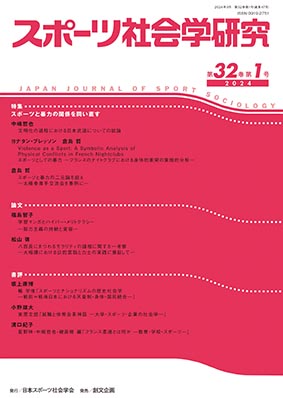Volume 32, Issue 1
Displaying 1-9 of 9 articles from this issue
- |<
- <
- 1
- >
- >|
Special Issues
-
2024Volume 32Issue 1 Pages 3-4
Published: 2024
Released on J-STAGE: December 28, 2024
Download PDF (192K) -
2024Volume 32Issue 1 Pages 5-23
Published: 2024
Released on J-STAGE: December 28, 2024
Download PDF (711K) -
2024Volume 32Issue 1 Pages 25-61
Published: 2024
Released on J-STAGE: December 28, 2024
Download PDF (2619K) -
2024Volume 32Issue 1 Pages 63-85
Published: 2024
Released on J-STAGE: December 28, 2024
Download PDF (1006K)
Original
-
2024Volume 32Issue 1 Pages 87-101
Published: 2024
Released on J-STAGE: April 30, 2024
Advance online publication: December 20, 2023Download PDF (651K) -
Article type: research-article
2024Volume 32Issue 1 Pages 103-116
Published: March 31, 2024
Released on J-STAGE: April 30, 2024
Download PDF (653K)
Book Review
-
2024Volume 32Issue 1 Pages 117-124
Published: March 31, 2024
Released on J-STAGE: March 03, 2025
Download PDF (361K) -
2024Volume 32Issue 1 Pages 125-131
Published: March 31, 2024
Released on J-STAGE: March 03, 2025
Download PDF (368K) -
2023Volume 32Issue 1 Pages 132-138
Published: March 31, 2023
Released on J-STAGE: March 03, 2025
Download PDF (325K)
- |<
- <
- 1
- >
- >|
